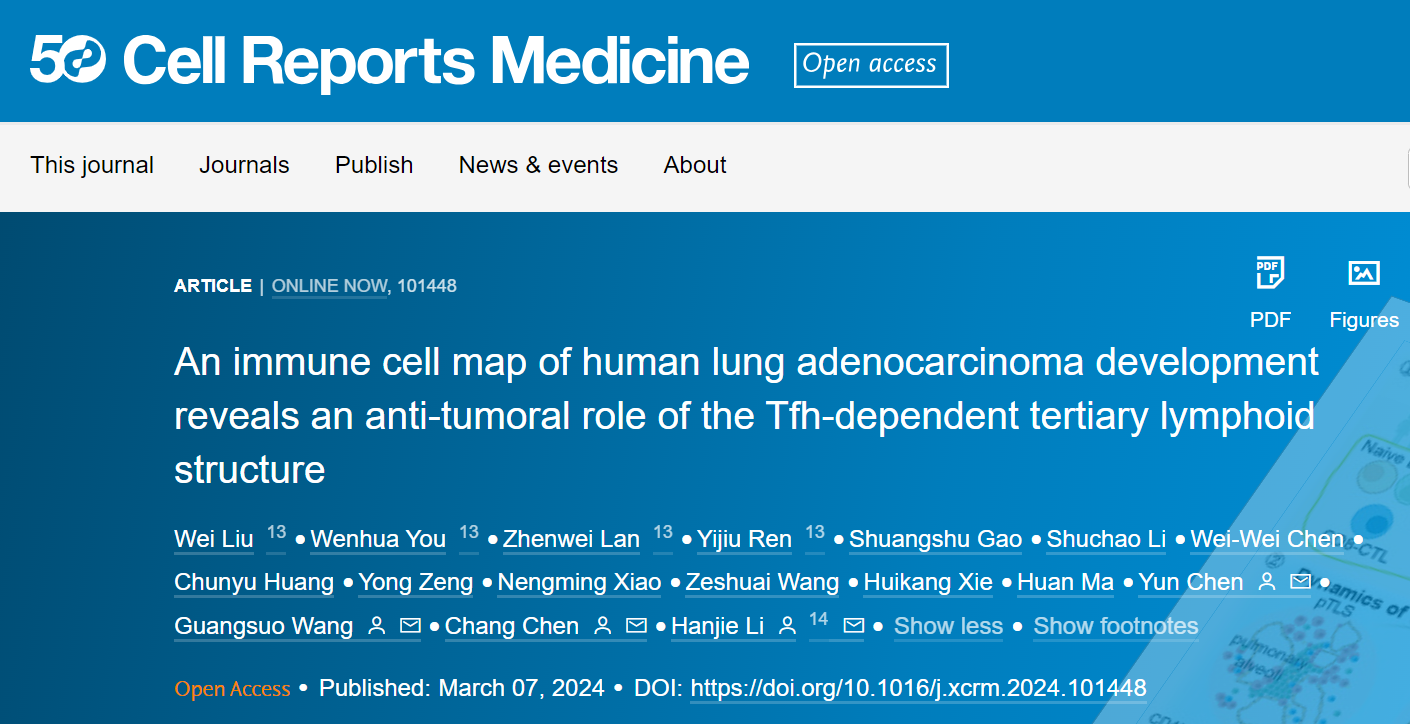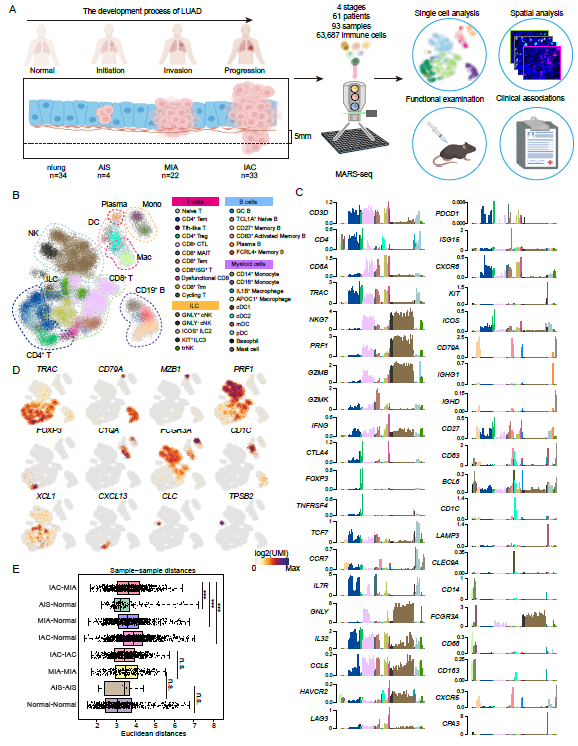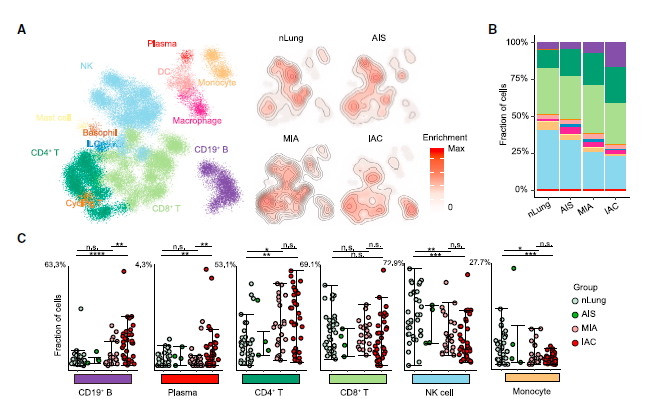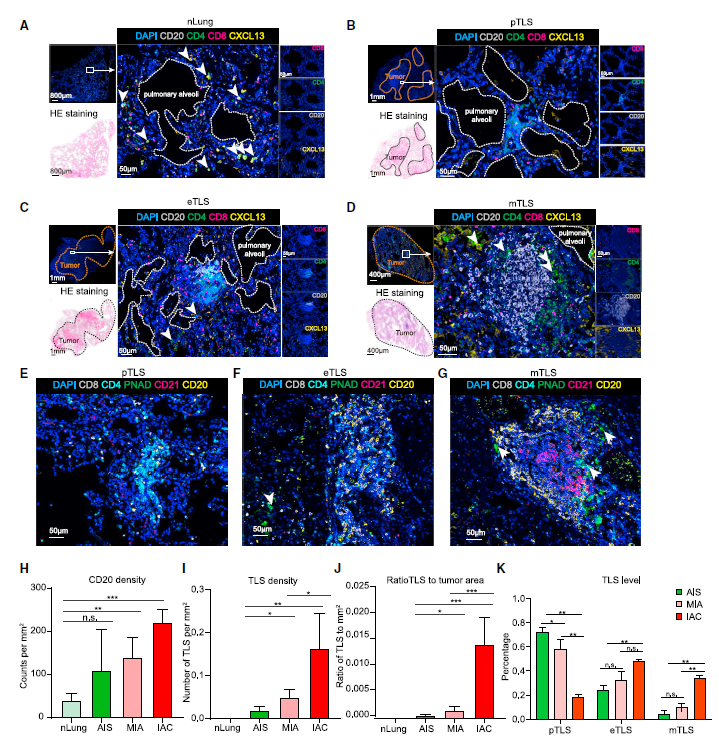
The development and progression of lung cancer is a process involving the steps of initiation, invasion, progression, and metastasis. Lung cancer cells have complex interactions with the immune microenvironment, accompanied by a series of dynamic changes in the immune microenvironment. Early-stage lung adenocarcinoma (LUAD) and its precursors include atypical adenomatous hyperplasia (AAH), invasive adenocarcinoma in situ (AIS), micro-invasive adenocarcinoma (MIA), and ultimately invasive adenocarcinoma (IAC). AAH and AIS belong to the precancerous lesions, and MIA and IAC belong to the invasive stage. Existing studies on early LUAD are mainly focused on the immune response at the IAC stage, while the dynamic immune evolution of early LUAD during initiation and invasion is still unclear.
On March 8, 2024, the research team led by Li Hanjie with Shenzhen Institute of Advanced Technology, Chinese Academy of Sciences, joined hands with organizations such as Nanjing Medical University, Shanghai Pulmonary Hospital and Shenzhen People’s Hospital, to publish an article titled “An immune cell map of human lung adenocarcinoma development reveals an anti-tumor role of the Tfh-dependent tertiary lymphoid structure” in the journal Cell Reports Medicine. The research team combined technologies such as single-cell transcriptome sequencing, advanced bioinformatics means, multiplex fluorescence immunohistochemistry, in vitro functional experiments to build a single-cell high-resolution map of immune cells in early lung adenocarcinoma progression. The team focused on T-follicular-assisted (Tfh-like) cells, germinal center B cells (GCB), and dysfunctional CD8+T cells to form tertiary lymphoid structures (TLSs), which has certain correlation with the prognosis of early lung adenocarcinoma. Further in vivo experiments demonstrated that Tfh cell-dependent tertiary lymphoid structures inhibited tumor growth via IL-21 / IL21R signaling. This study demonstrated the antitumor effect of Tfh cell-dependent tertiary lymphoid structures in early-stage lung adenocarcinoma (Figure 1).

Screenshot of the article
Link: https: / / www.cell.com/cell-reports-medicine/fulltext/S2666-3791(24)00071-5

Figure 1 The immunodynamic cell atlas during development and progression of human LUAD mapped to demonstrate that Tfh-dependent tertiary lymphoid structure can inhibit tumors and reveal the molecular mechanisms
The research team mapped a single-cell atlas of 63,687 immune cells from 93 samples, including 34 cases of normal lungs, 4 cases of AIS, 22 cases of MIA and 33 cases of IAC to reveal immune dynamics during the development of early LUAD. They identified nine major immune cell subtypes, including CD4+T cells, CD8+T cells, NK cells, dendritic cells, macrophages, monocytes, B cells, plasma cells, and innate lymphoid cells (ILC). On this basis, the research team conducted a more detailed classification of each major immune cell type, and finally annotated 30 immune cell subtypes (Figure 2).

Figure 2 Immune-dynamic cell atlas during the development and progression of human lung adenocarcinoma
The researchers discovered that B cells, plasma cells and CD4+T increased significantly during early LUAD’s initiation and invasion, while the proportion of NK cells and monocytes gradually decreased. By spatio-temporal analysis, Tfh-like cells, G C B cells, and dysfunctional CD8+T cells increased during tumor initiation / invasion and formed TLS within the tumors (Figure 3).

Figure 3 Dynamic changes of immune cells during the development and progression of early lung adenocarcinoma
Then the researchers deeply explored the process of TLSs formation in the progression of early lung adenocarcinoma. In the normal lung tissues, the C D4+T, C D8+T and B cells were scattered; there was an aggregation of CD4+T cells in the lung microenvironment, accompanied by sporadic CD8+T and B cells, which are called precursor TLSs (pTLSs). With the progression of tumors, Tfh-like cells with high expression of CXCL13 appeared in the aggregation area, which recruiting B cells, which are called early TLSs. With the differentiation and maturing of B cells, CD21+ follicular helper cells (FDC) and PNAD+ high endothelial microvein (HEV) appeared in the aggregation area, which eventually formed mature TLSs (Figure 4).

Figure 4 TLS formation in early-stage lung adenocarcinoma
Furthermore, TLSs and their constituent cells were closely associated with better survival of IAC patients (Figure 5). Further studies revealed that inhibition of the formation of TLSs by Tfh or B cell depletion promoted tumor growth. The antitumor effects of TLSs may be mediated through the IL21-IL21R signaling pathway. This study confirmed the antitumor role of Tfh-dependent TLSs in the progression of LUAD.

Figure 5 TLS is positively correlated with the prognostic outcome in early lung adenocarcinoma
Li Hanjie, a researcher with Shenzhen Institute of Advanced Technology, Chinese Academy of Sciences, professor Chen Chang from Shanghai Pulmonary Hospital, Wang Guangsuo, director of Shenzhen People’s Hospital, and Chen Yun, professor of Nanjing Medical University are the corresponding authors of this article. Liu Wei, a distinguished researcher with Guangdong Medical University, You Wenhua, a PhD candidate of Southeast University (co-cultivated with Southern Medical University), Lan Zhenwei, a PhD candidate of Xiamen University, and Ren Yijiu, an associate researcher with Shanghai Pulmonary Hospital, are first authors of the article.
Talents Wanted
The research team led by Li Hanjie adopted the research paradigm of “dual driving of data and hypothesis” and applied computational biology, molecular cell biology, clinical samples and animal models to deeply explore the diversity, differentiation and function of human immune system under the states of development, health and illness. He has published several high-level papers as the first or corresponding author (including co-author) in journals such as Cell (2023, 2019), Cell Research (2020,2012), Cell Reports Medicine (2024), Cellular and Molecular Immunology, Cell Discovery, Cell Reports, with a total of 3,800 citations. His research achievements were selected among the top ten pieces of domestic science and technology news in 2023 (Science and Technology Daily), and the top ten major events of science and technology innovation in Shenzhen in 2023 (Shenzhen Special Zone Daily). He has won the honors and titles such as “Overseas High-level Talents Youth Program” of the Organization Department of the CPC Central Committee, the “Mary-Curie Scholarship” and the “Humboldt Scholar” of Germany. As the chief scientist, he has headed the key program of “developmental programming and its metabolic regulation” of the Ministry of Science and Technology.
In addition, the Laboratory will recruit postgraduate candidates / postdoctoral fellows in computational biology, molecular cell biology, immunology and basic medicine for a long time. You are welcomed to send any inquiry and join our research team. (email:hj.li@siat.ac.cn).